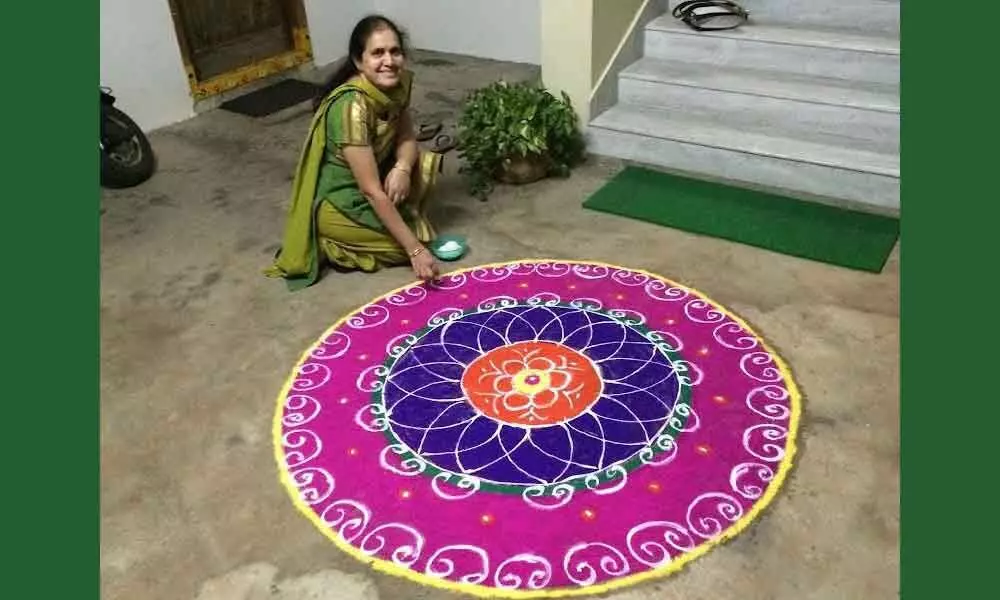Cherishing a bond over connecting dots!

Jyothi Vajjhala giving finishing touches to a rangoli pattern at her home in Visakhapatnam
Apart from following our culture and invoking Goddess Lakshmi, drawing a rangoli gives an immense pleasure and helps improve to artistic skills
A concoction of turmeric powder and water is made to sprinkle along the front yard after sweeping it clean.
Once the chore is completed and the floor dries a little, the equidistant dots of the white-coloured powder trickle down the fingers to get connected into an intricate 'kolam' (in Tamil) or 'muggu' (in Telugu).
Come 'Dhanur masam', rangolis gain larger significance in traditional households as the scrapbooks containing various designs are pulled out of the shelves or the ones stored in memories are recollected to experiment along the water-sprinkled thresholds.
A lot of preparation gets into each pattern and the exercise begins much before the break of dawn amid balmy winter mornings. For those who have been practicing the rangoli-drawing ritual for years, there is always a reason to continue following it. "Due to chillness in the weather, during 'dhanur masam' in particular, many experience stiffness of joints. By drawing 'muggu', our body becomes flexible as we need to stretch our arms and legs while designing and pouring life into each pattern. In traditional households, the festive mood is often ushered in through a well-drawn muggu. Also, placing vermilion, turmeric and flowers as a part of the 'gobbemmalu' epitomises wealth. There is a belief that Lord Vishnu stays where Goddess Lakshmi is present. So, by drawing a rangoli and decking it up with gobbemmalu, we usher them into our home and life," explains Jyothi Peddibhotla, music and Sanskrit teacher.
While some incorporate 'muggu pindi' (powder) for designing rangoli, others use 'kola mavu' (rice batter) altered to get the required consistency. "The batter should not be too thick or too watery. It should just trickle down the fingers comfortably through the piece of cloth we hold. 'Ma-kolam' (rangoli made of rice batter) has its own charm, especially when it is outlined with 'chemman' (diluted red brick powder). The combination of ma-kolam and chemman signifies the presence of Goddess Lakshmi and Lord Vishnu. In those days, a woman's qualities used to be assessed through the patterns of kolam drawn," says G Radhamani, a Tamilian.
Those following the tradition of drawing rangoli say that they bond over the ritual as they feel a special connection towards it. "Apart from following our culture and invoking Goddess Lakshmi, drawing a muggu gives me immense pleasure and helps improve my artistic skills. For me, rangoli is a symbol of positivity and it elevates the beauty of our home," says Jyothi Vajjhala, a homemaker.
Sharing scientific reasons behind practicing the ancient ritual, researcher and astrologer Rambhatla Venkata Raya Sarma says, "During winter season, there is a need to guard ourselves from bacteria and other harmful organisms. For eons, turmeric is considered as an antiseptic agent. Similarly, cow dung contains cleansing properties. Together, they make a great combination in warding off microorganisms from making way into our homes. Maintaining the front yard clean and decorating it with 'muggu' personifies wealth. When the house is maintained clean, it will eventually aid in keeping our health disease-free." Godha Devi (Aandal) is worshiped during Dhanur masam. Although a number of options such as predesigned templates are available in the market to ease the process of drawing a rangoli, women in traditional households agree that nothing replaces the charm of a hand-drawn pattern.














